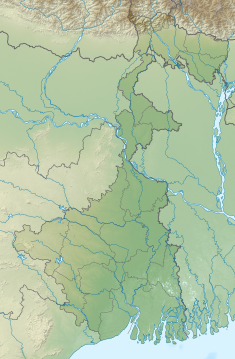|
Murguma Dam
The Murguma Dam[1] is constructed on the Saharajhore River,[2] one of the tributary of Kangsabati River in West Bengal, India. The dam is constructed near Murguma[3] village in the foothill of Ajodhya Hills, Purulia District. It's under the jurisdiction of Kotshila Police Station. A number of other streams also flow into the dam directly from Ajodhya Hills. The dam is surrounded by hills, forests and a number of small islands[4] within it. The place is situated at the north west end of Ajodhya Hills which is considered as an eastern extension of Chota Nagpur Plateau. People and economyThe area is mainly inhabited by tribal people,[5][1] with Santal people predominant.[6] The economy is mainly dependent on agriculture.[7] However, the place has potential to be a tourist attraction which might improve economic conditions for the local people. The government is promoting this place as a tourist destination.[3] This dam is a part of one of the key small irrigation projects[8] in rural as well as arid areas of West Bengal[2][6] having a considerable percentage of tribal population.[6][5] It is one of the promising tourist spots of Eastern Chota Nagpur Plateau region. To date, no facility of boating offered. The dam and surroundings are preferred locations for backpackers.[9] The dam features in the tourism brochure of Government Tourist Department of Purulia District.[10] AccessibilityThe nearest railway station is Jhalda, from where the place is accessible by single metalled road. The other option is to follow the Purulia-Tamna more-Arsha-Begunkodor-Murguma route for 50 km (31 mi). The accessibility is not good but that is perhaps one of the reasons that the locality still offers wild beauty. Distance from nearby places: Ajodhya Hills Top = 20 km (12 mi) Jhalda = 16 km (9.9 mi) Begunkodor town = 6 km (3.7 mi) Begunkodar rail FH = 12 km (7.5 mi) Kolkata = 340 km (210 mi) Purulia = 50 km (31 mi) Durgapur = 185 km (115 mi)(via Bankura) 165 km (103 mi) (via Asansol), Bankura = 140 km (87 mi) Jamshedpur = 110 km (68 mi) Ranchi = 95 km (59 mi) Asansol = 134 km (83 mi) MiscellaneousBeing far from urban disturbance, this dam is a location for research on indigenous aquatic flora[11][12] and fauna.[13] This area was affected by Maoist insurgency a few years back but now returned to normalcy.[14] Gallery
References
|
||||||||||||||||||
Portal di Ensiklopedia Dunia






















